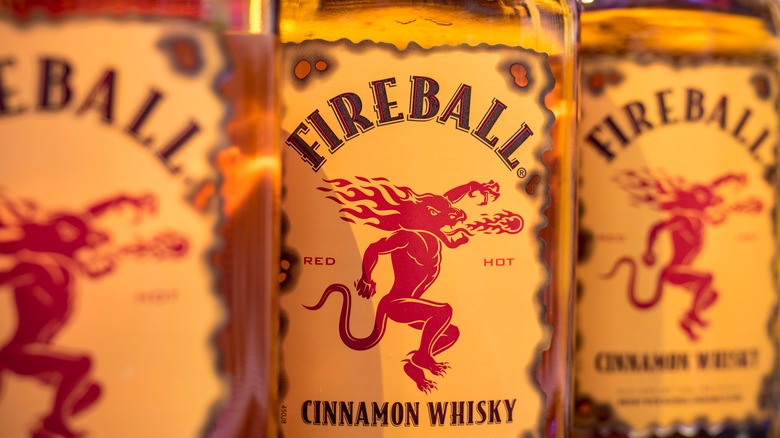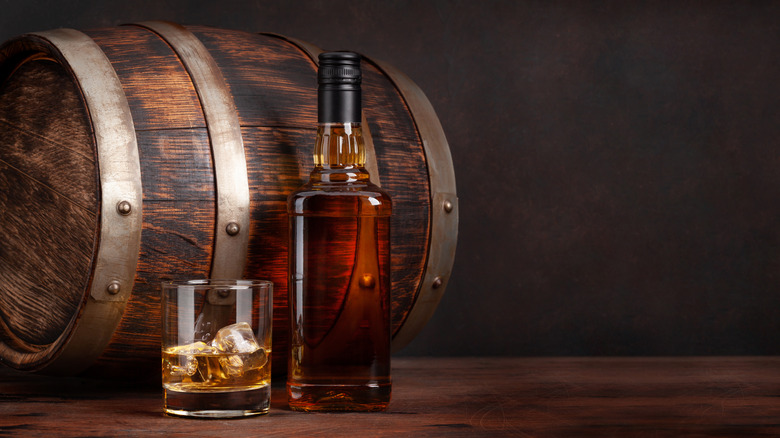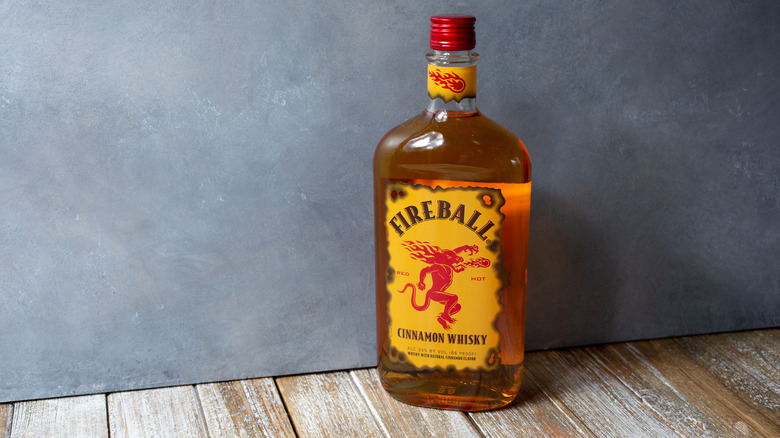Why Fireball Isn't Technically Considered Whisky
Whiskey is a popular alcoholic spirit that's made from fermented wheat, barley, corn, or rye and is distilled and aged in wooden barrels or casks, according to MasterClass. While there are various types of whiskey, the overall flavor profile of the spirit is often considered to be sweet and caramel-like yet spicy, warm, and toasty. Distilled spirits were allegedly created in 13th-century Italy from wine in the form of tonics that were solely for medical uses. Later in the 15th century, people in Scotland and Ireland began distilling spirits for recreational use, and the process continued to spread throughout Europe.
One of today's well-known whiskey brands is Fireball Cinnamon Whisky, which people either love to drink or cringe at the thought of. Fireball was created in the 1980s in Canada by Seagram's and was actually classified as flavored schnapps at first, per Whiskey Raiders. Fireball was sold to Sazerac Company in 1989, and until 2007, it was known as Dr. McGillicuddy's Fireball Whisky. You'd be surprised to know that Fireball Cinnamon Whisky technically isn't a whiskey. Here's why.
True whiskey must have at least 40% ABV
Per MasterClass, for an alcohol to be a true whiskey, it must have an alcohol by volume (ABV) of at least 40%. Each whiskey type is differentiated based on what grain(s) it's made with, where it originates, how it's aged, and how it's blended. Bourbon whiskey is mostly made in Kentucky, requires a minimum of 51% corn, and must be kept in oak barrels for aging. Tennessee whiskey has a similar makeup to bourbon and is refined and processed with sugar maple charcoal before it's poured into oak barrels for aging. Single malt whiskey is made of a single malted grain type from a single distillery. Rye whiskey must be made with a minimum of 51% rye and held in oak barrels for aging like bourbon.
Irish whiskey has to be completely produced in Ireland and be made from barley, cereal grain, and malt. It must be kept in wooden kegs for at least three years to age. For a whisky to be classified as Scotch, it must be fully produced in Scotland and left to age in oak barrels for at least three years. Japanese whisky is aged in Japanese oak barrels and must be bottled in Japan, while blended whiskeys are a combination of various types of whiskey. One final whisky type is Canadian, which must have at least 40% ABV, be fully produced in Canada, and be stored in wooden casks of less than 700 liters for a minimum of three years.
Fireball has an ABV of 33%
Fireball Whisky is made with Canadian whisky, cinnamon flavoring, and sweeteners, among other ingredients, per Whiskey Raiders. According to Fireball Whisky, the original Fireball Cinnamon Whisky is made to be 66-proof with an ABV of 33%. Even though the majority of Fireball's contents is Canadian whiskey, it can't legally be labeled as such because the ABV is less than 40%. The same would be true if Fireball's base was any other type of whiskey, including Scotch, Irish, Japanese, Tennessee, or another. While the Canadian whisky that Fireball is made with probably starts out at 40% ABV as legally required, the end product is diluted with cinnamon flavoring and sweeteners.
On the flip side, Fireball is allowed to label its products as whisky since it's categorized as a flavored whiskey due to the addition of sweeteners and cinnamon flavoring. Flavored whiskeys in the United States have to have a minimum ABV of 30%, and because the original Fireball has 33% ABV, the alcohol brand is allowed to call itself a cinnamon whisky, according to Whiskey Raiders. So, while Fireball is technically a whiskey, according to flavored-whiskey standards, some aficionados would certainly argue against it.


